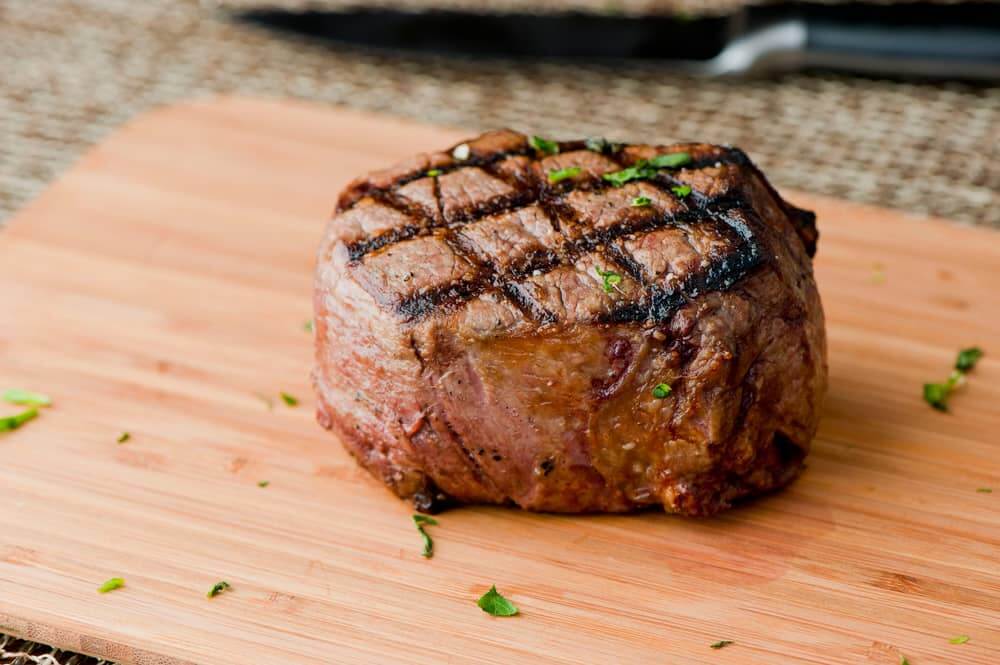
It’s hard to resist a delicious, tender, and juice filet mignon. This piece of beef cut from the very best part of the tenderloin is one of the most prized options for people who love upscale steak dishes. It crisps up nicely on the outside while staying tender and moist on the inside.
Steak nutrition is sometimes debated. It typically comes with lots of calories and fat, depending on the cut and how it’s trimmed. However, steak has a lot of heart-healthy benefits, too, like being friendly for low-carb diets and containing good-for-you vitamins. Like other steaks, filet mignon has its pros and cons when it comes to your nutrition.
Here are some filet mignon nutrition facts you should know.
Filet Mignon Nutrition
A suggested serving of filet mignon is 3 ounces. Here’s how filet mignon nutrition breaks down in that serving, according to the USDA:
- Calories: 227
- Total Fat: 15 g
- Saturated Fat: 6 g
- Cholesterol: 82 mg
- Sodium: 46 mg
- Potassium: 280 mg
- Carbohydrates: 0 g
- Protein: 22 g
When you consider that most USDA prime filets are cut to at least 6 ounces, you’ll need to remember that you’ll probably eat about double the recommended serving size. So, that means one of these filets will take up about 450 of your daily calories and 30 grams of your daily fat allowance.
Of course, these nutrition facts only scratch the surface with everything filet mignon contains. So, continue reading to get a more detailed breakdown of the good and not-so-good things about filet mignon nutrition.
The Good
Here’s the low-down on some good-for-you filet mignon nutrition facts.
Excellent Protein Source
A major draw for most meat-eaters is the protein packed into a single serving. Any kind of steak cut has high protein content, so filet mignon is no exception. A 3-ounce portion packs in 22 grams of protein, which is about ⅓ of the suggested daily intake for a 165-pound person. If you’re eating a larger portion of filet mignon, you can easily get most of your protein intake from just one meal.
Low-Carb Friendly
In addition to filling you up with muscle-building protein, filet mignon doesn’t provide any carbohydrates alongside that protein. That’s good news for people who follow a ketogenic or low-carb diet plan or simply want to avoid eating frivolous carbs. According to Mayo Clinic, low-carb diet plans can also aid in weight loss and lower heart disease and type 2 diabetes risk.
Iron and Zinc Content
Iron and zinc work together in the body to boost your overall health. Iron is necessary for healthy amounts of red blood cells that carry oxygen throughout the body, while zinc speeds up metabolism and aids your immunity. According to the National Institutes of Health, adults need between 8-11mg of zinc and 8-18mg of iron each day. USDA’s data shows that a single 3-ounce serving of filet mignon provides about 3mg of zinc and close to 3mg of iron.
Vitamins B-6 and B-12
Many expert sources agree that getting vitamins from food is the best and healthiest way to do it. Vitamins B-6 and B-12 are plentiful in filet mignon, making it a relatively good source for these beneficial nutrients. Vitamin B-6 supports brain development and immunity, while B-12 assists a host of bodily processes, like making red blood cells and forming DNA.
Low Sodium
The Dietary Guidelines for Americans suggests eating less than 2,300mg of sodium each day. Per the CDC, sodium has links to heart disease because it can cause heart-unhealthy side effects, like raising blood pressure. Fortunately, a 3-ounce portion of filet mignon only holds less than 50mg of sodium. Pair it with healthy, low-sodium side dishes, like steamed spinach or a baked sweet potato, for a balanced meal.
The Not-So-Good
Filet mignon nutrition mostly includes perks for a well-balanced diet, but there are also a couple of cons to consider.
Saturated Fat
Some fats are necessary in your diet. However, saturated fat is one you want to avoid as it can raise the bad cholesterol in the body. The American Heart Association recommends getting no more than 6% of your daily calories from saturated fat, which equates to around 13 grams. You get about half of those grams from a 3-ounce portion of filet mignon, and a larger portion could easily make you reach your cap for the day.
Calorie-Dense
The calorie content of a 3-ounce portion of filet mignon is relatively good at 227 calories. That’s only slightly higher than a 3-ounce piece of chicken. But, considering that many people typically eat more than three ounces when they have a piece of steak, it’s important to be mindful of how many calories you’ll consume if you do that. In the case of filet mignon, a typical double-size portion drives the calories over 450.
Conclusion: Filet Mignon Nutrition Facts
Filet mignon can be a healthy addition to a well-balanced diet. However, consumers should be careful about portioning, sticking to a suggested serving size of three ounces. This is on the small side for filet mignon, but portion control can help you manage calories and saturated fat in your diet. For an even healthier meal, be mindful of the side dishes you choose with your steak.
Consider ordering bone-in or boneless filet mignon from Chicago Steak Company for delivery.

